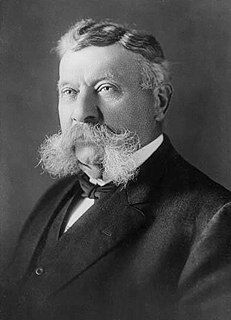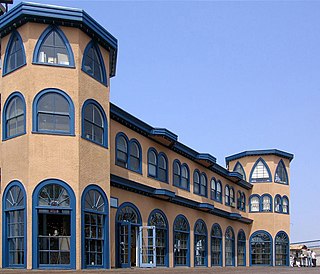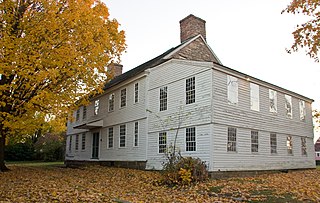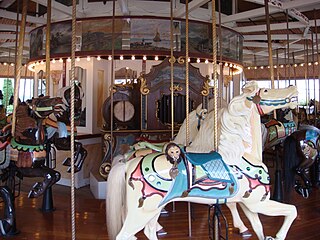
Fenwick is a borough in Middlesex County, Connecticut, United States, in the town of Old Saybrook. The population was 52 at the 2000 census, making it the least populous borough in Connecticut. It is a popular summer colony. Most of the borough is included in Fenwick Historic District, a historic district listed on the National Register of Historic Places. In 1995, the district included 66 contributing buildings and one other contributing site.

The Stonington Harbor Light is a historic lighthouse built in 1840 and located on the east side of Stonington Harbor in the Borough of Stonington, Connecticut. It is a well-preserved example of a mid-19th century stone lighthouse. The light was taken out of service in 1889 and now serves as a local history museum. It was listed on the National Register of Historic Places in 1976.

Sheffield Island Light is a historic lighthouse located at the southern end of the Norwalk Islands in Norwalk, Connecticut. It marks the west side of the mouth of the Norwalk River on northern Long Island Sound.

The Boca Chita Key Historic District is a U.S. historic district within the Biscayne National Park in Miami-Dade County, Homestead, Florida. Located on the northwest section of Boca Chita Key, delimited by Biscayne Bay in the north and west and a half ruined stone wall on its southern side, it contains three historic buildings and the Boca Chita Lighthouse. On 1 August 1997, it was listed in the National Register of Historic Places for its architectural, historical and recreational values.

The Lynde Point Light or Lynde Point Lighthouse, also known as Saybrook Inner Lighthouse, is a lighthouse in Connecticut, United States, on the west side of the mouth of the Connecticut River on the Long Island Sound, Old Saybrook, Connecticut. The first light was a 35 feet (11 m) wooden tower constructed by Abisha Woodward for $2,200 and it was completed in 1803. A new lighthouse was eventually needed and a total of $7,500 was appropriated on July 7, 1838. Jonathan Scranton, Volney Pierce, and John Wilcox were contracted to build the new 65-foot (20 m) octagonal brownstone tower. It was constructed in 1838 and lit in 1839. The lighthouse was renovated in 1867 and had its keeper's house from 1833 replaced in 1858 with a Gothic Revival gambrel-roofed wood-frame house. In 1966, the house was torn down and replaced by a duplex house. The original ten lamps were replaced in 1852 with a fourth-order Fresnel lens, and with a fifth-order Fresnel lens in 1890. Lynde Point Lighthouse used whale oil until 1879 when it switched to kerosene. It was electrified in 1955 and fully automated by the United States Coast Guard in 1978. In 1990, it was added to the National Register of Historic Places and is significant for its "superior stone work in the tapering brownstone walls".

Southwest Ledge Light is an active lighthouse marking the main entrance channel to the harbor of New Haven, Connecticut. Completed in 1877, it was one of the first to be built on a cylindrical iron foundation, an innovation by Maj. George H. Elliot to address shifting ice that is regarded to be very important in lighthouse design. The lighthouse was listed on the National Register of Historic Places in 1990 as Southwest Ledge Lighthouse.

Charles I. D. Looff was a German master carver and builder of hand-carved carousels and amusement rides, who immigrated to the United States of America in 1870. Looff built the first carousel at Coney Island in 1876. During his lifetime, he built over 40 carousels, several amusements parks, numerous roller coasters and Ferris wheels, and built California's famous Santa Monica Pier. He became famous for creating the unique Coney Island style of carousel carving. A carousel museum is located at 2500 Long Beach Blvd, Long Beach, California.

The Santa Monica Looff Hippodrome is located on the Newcomb Pier adjacent to the Santa Monica Pier in Santa Monica, California. It was designed and built in 1916 by Charles I. D. Looff and his son Arthur to hold a Looff Carousel. Looff's carousel was housed at the Hippodrome until it was sold in 1939. It was replaced by Philadelphia Toboggan Company Carousel #62, which was moved from the Ocean Park Pier. The building remains a rare example of structures that used to be on the amusement pier, and scenes were filmed therein for the 1973 award-winning film, The Sting. Since 1977, the carousel has been owned by the city, and was restored from 1977 through 1981. It was declared a National Historic Landmark in 1987.

Santa Cruz Looff Carousel and Roller Coaster On The Beach Boardwalk is a National Historic Landmark composed of two parts, a Looff carousel and the Giant Dipper wooden roller coaster, at the Santa Cruz Beach Boardwalk in Santa Cruz, California, United States. They are among the oldest surviving beachfront amusement park attractions on the west coast of the United States. They were listed as a pair as a National Historic Landmark in 1987.

Crescent Park Looff Carousel, also known as Crescent Park Carousel or more officially as Crescent Park Looff Carousel and Shelter Building, is a National Historic Landmark in East Providence, Rhode Island.

Slater Park is the oldest and largest public park in Pawtucket, Rhode Island. The park is named after Samuel Slater, a famous American industrialist who constructed America's first water-powered textile mill in Pawtucket. The park lies on the banks of the beautiful Ten Mile River and features the 1685 Daggett House, the oldest house in Pawtucket. The park was added to the National Register of Historic Places in 1976. It also features an original Looff Carousel.

The Riverfront Park Carrousel, also known as the Looff Carrousel and the Natatorium Park carousel, is a carousel in Spokane, Washington, built in 1909 by Charles I. D. Looff as a gift for Looff's daughter Emma Vogel and her husband Louis Vogel, who owned Natatorium Park in Spokane. It remained at the park until 1968 when the park closed. The carousel was relocated to its present location at Riverfront Park in 1975 where it continues to operate. It was added to the National Register of Historic Places on September 19, 1977.

The Willimantic Freight House and Office is a historic railroad freight facility on Bridge Street in the Willimantic section of Windham, Connecticut. Built in 1870, the freight office, a fine example of Second Empire architecture, is now the only surviving element of the city's 19th-century railroad buildings; the freight house has been demolished. The buildings were listed on the National Register of Historic Places in 1982 as an important reminder of the city's importance as a major railroad junction in eastern Connecticut.

Lakeside Park is a historic "pleasure ground" park located at Owasco on Owasco Lake in Cayuga County, New York. It is a 40-acre (16 ha) park located within the boundaries of Emerson Park, a 130-acre (53 ha) municipal park system. The property includes four contributing design and architectural features: the remaining 25-acre (10 ha) park, including the primary and secondary paths and walkways, vistas, vegetation, and cast-iron lampposts and benches; and the Pavilion, Carousel Shelter, and Refreshment / Concession Stand. The park was originally designed and laid out in 1895 by the Auburn and Syracuse Electric Railroad Company. A Charles I. D. Looff carousel was installed in 1900. In 1908, this ride was replaced by another Looff carousel. The focal point of the property is the Pavilion; a Colonial Revival style dance hall and restaurant facility completed in July 1912. The Carousel Shelter, a twelve-sided structure built in 1921, once held a 1915 Herschell Spillman Company carousel with 51 animals. In 1972, it was converted into a summer theater. The Refreshment / Concession was also built in 1921 and moved to its present location in 1921.

The John Cook House is a historic house at 35 Elm Street in New Haven, Connecticut. Built about 1807, it is one of the city's oldest surviving stone buildings, further notable for a parade of locally or statewide prominent residents. The house was listed on the National Register of Historic Places in 1983.

The Pardee-Morris House, also known as John Morris House, is a historic house museum at 325 Lighthouse Road in New Haven, Connecticut. Probably built in the late 17th century, it is one of New Haven's oldest surviving buildings, and a good example of First Period colonial architecture. The building was listed on the National Register of Historic Places in 1972. It is now owned and operated by the New Haven Museum and Historical Society, and is open seasonally for events, classes and tours.

The Welch Training School, also known as the Welch School, is a historic school building at 495 Congress Street in New Haven, Connecticut. Built in 1883, it is a good example of Queen Anne architecture as applied to school buildings, and was the city's first teacher training school. It was listed on the National Register of Historic Places in 1983. The building now houses a substance abuse clinic.

Lake Compounce Carousel is a historic carousel at Lake Compounce amusement park in Southington, Connecticut. It was designed by Charles I. D. Looff and built in 1890. A rare surviving operational Looff carousel, it was added to the National Register of Historic Places in 1978.

The Patrick Murphy House is a historic house at 345 Palisado Avenue in Windsor, Connecticut. Built about 1873, it is a good example of Italianate architecture executed in brick. It was listed on the National Register of Historic Places in 1988.





























